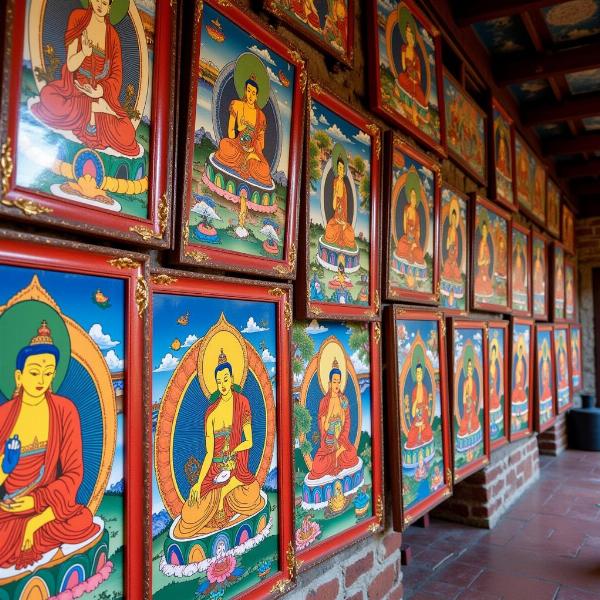Thanka meaning in Hindi revolves around the rich tradition of Tibetan Buddhist scroll paintings. These vibrant and intricate artworks are more than just aesthetically pleasing; they hold deep religious significance and serve as powerful tools for meditation and spiritual practice. This article explores the multifaceted meaning of thankas, delving into their symbolism, creation process, and cultural importance within the Tibetan Buddhist context.
Understanding the Term “Thanka” in Hindi
The word “thanka” (sometimes spelled “thangka”) doesn’t have a direct, single-word equivalent in Hindi. It is often referred to as “तिब्बती चित्रकला” (Tibbati chitrakalā), meaning “Tibetan painting,” or more specifically, “धार्मिक चित्रकला” (dhārmik chitrakalā), meaning “religious painting.” While these terms capture the essence of thankas as artistic expressions, they don’t fully encompass their spiritual depth and ritualistic function. Therefore, the term “thanka” itself is commonly used in Hindi when discussing these specific types of Tibetan Buddhist art. Understanding the nuanced meaning of “thanka” requires exploring its Tibetan origins. The word “thanka” comes from the Tibetan word “thang-ka,” which literally means “recorded message” or “something that can be rolled up.” This emphasizes the portability of thankas, allowing them to be easily transported and displayed for religious teachings and ceremonies.
The Symbolism and Significance of Thankas
Thankas are imbued with profound symbolism. Each element, from the deities depicted to the colors employed, carries specific meaning. Common subjects include Buddhas, bodhisattvas, mandalas, and scenes from Buddhist scriptures. These depictions serve as visual aids for meditation, helping practitioners connect with the teachings and cultivate spiritual understanding. The vibrant colors, such as gold, blue, red, and green, also hold symbolic significance, representing different aspects of enlightenment and the Buddhist cosmos. For instance, gold symbolizes achievement and enlightenment, while blue represents wisdom and knowledge.
The Creation of a Thanka: A Sacred Process
Creating a thanka is not merely an artistic endeavor; it is a sacred practice. Trained artists, often monks or nuns, undergo rigorous training to master the intricate techniques involved. The process begins with the preparation of the canvas, traditionally made of cotton or silk. Then, the artist meticulously sketches the composition, following established iconographic guidelines. Natural pigments derived from minerals and plants are used to create the vibrant colors. The entire process is accompanied by prayers and rituals, imbuing the thanka with spiritual energy.
Thanka’s Role in Tibetan Buddhist Culture
Thankas play a vital role in Tibetan Buddhist culture, serving as focal points for devotion, education, and ritual practices. They are displayed in monasteries, homes, and during religious festivals, offering a visual representation of Buddhist teachings and inspiring practitioners on their spiritual path. Their portability also allows them to be used in nomadic communities, ensuring that the teachings and blessings of Buddhism can reach even remote areas.
What does a thanka represent?
Thankas represent various aspects of Tibetan Buddhist philosophy and cosmology, serving as visual aids for meditation and spiritual practice.
How is a thanka made?
Thankas are created using traditional methods, involving the preparation of a canvas, meticulous sketching, and the application of natural pigments.
Why are thankas important in Tibetan Buddhism?
Thankas are important in Tibetan Buddhism as they serve as focal points for devotion, education, and ritual practices, offering a visual representation of Buddhist teachings.
Conclusion: Thanka Meaning in Hindi – More Than Just a Painting
Understanding the thanka meaning in Hindi requires recognizing its significance beyond its artistic value. It is a sacred object, a visual representation of Tibetan Buddhist teachings, and a powerful tool for spiritual practice. Whether displayed in a monastery or a home, a thanka serves as a constant reminder of the path to enlightenment.
 Thanka Display in a Tibetan Monastery
Thanka Display in a Tibetan Monastery
FAQ
- What is the primary purpose of a thanka? Thankas serve as visual aids for meditation and contemplation, helping practitioners connect with Buddhist teachings.
- What materials are used to create a thanka? Traditional thankas are painted on cotton or silk canvas using natural pigments derived from minerals and plants.
- Are thankas only found in Tibet? While originating in Tibet, thankas are also found in other regions influenced by Tibetan Buddhism, including Nepal, Bhutan, and parts of India.
- Can anyone create a thanka? Traditionally, thankas are created by trained artists, often monks or nuns, who undergo rigorous training.
- How should a thanka be displayed? Thankas are typically displayed on walls, often framed with brocade, and treated with reverence.
- What is the significance of the colors used in a thanka? The colors in a thanka hold symbolic meaning, representing different aspects of enlightenment and the Buddhist cosmos.
- Where can I learn more about thankas? Museums, art galleries, and specialized books on Tibetan Buddhist art are excellent resources for further exploration.
Related Articles
Meaning-Hindi.in specializes in providing accurate and culturally sensitive translation services between Hindi and various other languages. Our expertise spans a wide range of fields, from business and legal documents to technical manuals and website localization. Whether you need to translate educational materials or require specialized interpretation, our team of experienced linguists can assist you. Contact us today for your translation needs at [email protected] or +91 11-4502-7584. Meaning-Hindi.in is your trusted partner for bridging language barriers.